I’ve met quite a few people who live in fear of winter travel, or even winter staying-at-home. They’re utterly terrified of single-digit temperatures, and lock themselves up at the first sign of cloud. I’d brag, but I do the same thing when it’s too hot outside.
But I always try to point out that winter adventures need not be horridly atrocious nightmares. With a few carefully-chosen items, winter travel gear can be comfortable, functional, lightweight, relatively inexpensive, and still keep you warm and toasty the whole time. And the cornerstone of this intricate jigsaw puzzle is a packable down jacket.
What can a packable down jacket do for me?
Long known for making gloriously cozy comforters, goose down has a number of advantages over other materials that make it ideal for lightweight backpacking, even outside of winter. It’s the best way to go from “I was trudging through the frozen waste” to “I was exploring a beautiful winter wonderland.”
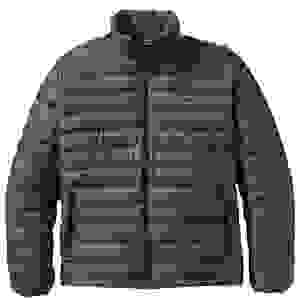
Observe:
- Warmth: Down is incredibly lofty, with millions of tiny bristles that keep warmth trapped inside. There’s very little on the planet as warm as high-quality goose down, particularly when it comes to materials that could actually make suitable clothing.
- Weight: The amount of down it takes to keep you warm weighs practically nothing, meaning you can make a down jacket that’ll be half the weight of comparably warm jacket made of other materials.
- Packability: All the loftiness that makes down warm and cozy also makes it incredibly compressible, meaning you can pack it into half the space of a typical fleece jacket.
And those are just the advantages of down itself; but since it’s almost always built into a jacket made of lightweight nylon, you get these added bonuses as well:
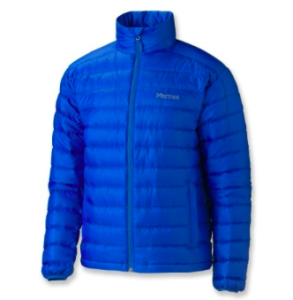
- Weather resistance: Pretty much all down jackets are windproof and water resistant, making them excellent outer layers, whereas even a thick fleece would probably still need an additional layer to keep out the wind.
- Silky smooth: They’re usually so frictionless that you can stuff a down jacket into nooks and crannies that would otherwise be empty, meaning it can often disappear into empty air pockets as if by magic. It also makes a nice, soft cushion for fragile belongings.
Where does a lightweight down jacket really excel?
Because of this particular combination of advantages, I find down jackets to be absolutely essential for ultralight winter travel, but they’re also quite useful in chilly fall or spring adventures. Instead of getting a super-warm parka, you can get a mid-weight jacket that’ll be useful in milder weather, and simply add other pieces when it gets down to freezing.

They’re also incredibly useful for the dreaded multi-season trip (or multi-elevation trip), which requires summer and winter gear to be packed into the same bag, with winter gear sitting uselessly half the time.
Since down jackets are lighter and more compressible than just about anything else, they’re by far the best option for these sorts of adventures. An unused down jacket will be half the size and weight of an unused anything-else jacket, making it a lot less annoying to haul around when not in use, allowing you to build a RTW packing list without much trouble.
My favorite setup is to use a lightweight fleece or wool zip-up sweater, which makes an excellent next-to-skin layer to wear over a t-shirt, and then add a packable down jacket on top, which makes an excellent weather-resistant outer layer. This allows for the versatility of multiple layers, while still remaining physically comfortable, fairly weather resistant, and light.
And now for details:
What the heck is fill power?
This is essentially the quality rating of the down. Fill power is the measurement of how much volume it fills up for a certain weight, after it’s compressed and allowed to expand once again. The higher the number, the better it is.

But since it’s a measure of both volume and weight, higher fill power doesn’t necessarily mean it’s warmer. It means it’ll be warmer for the same weight, or it’ll be lighter for the same warmth. More packable, too.
So yes, higher is better, but keep in mind it doesn’t necessarily mean a jacket with a higher fill power will be warmer. You could easily have a 600 fill power jacket just as warm as an 800 fill power jacket; it’s just that the 800 fill power jacket would probably be lighter and more packable, though it would also depend on thickness of fabric, how many zippers it has, overall length, and so on. A lower fill power will also be significantly cheaper, though you’ll be compromising somewhat on weight and compressibility.
What’s a good fill power?

Most down jackets are somewhere around 400 to 600, but premium brands, such as those you’d find in a camping store, are typically around 800. They’ll cost more, but you’ll maximize the benefits of warmth, weight, and compressibility, and it’s not a bad investment if you live somewhere cold.
I’ve seen fill power go up to 1000, but it’s extremely rare, and quite expensive, as it requires selecting the highest quality feathers by hand. If you need the absolute best, well then okay. But keep in mind it’s only going to be 25% warmer (or 25% lighter) than 800 fill power down, but it could be twice as expensive.
For most purposes, 800 will be super warm, exceptionally light, and easily packable. And it’ll say it’s 800 right on the label. If you can’t find the fill power, you can be pretty sure it’s significantly lower, since they don’t want to bring attention to it. But again, a lower rating might not be so bad, particularly if you don’t plan on using it so often, or if you have plenty of space in the pack, and so on.
How much should I spend?
A high-quality down jacket can be anywhere from $100 to $1000. But typically they’ll be in the $150 to $250 range. Lower fill powers can bring the price down to $50, but it won’t be as ultralight or packable as you might want.

Since the raw material can be expensive, particularly for higher-quality down, there will often be a direct correlation between warmth and cost, meaning a lightweight down jacket might be $150, whereas a serious winter parka might be more like $300 or more. With exceptions, of course.
Personally, I prefer to keep each individual piece pretty light, and add extra layers during winter. A super-warm winter parka will only be useful in the winter, whereas a lighter jacket might be useful year-round when combined with other layers, so you won’t have to spend so much anyway. This will of course depend on where you live and travel, and how cold you usually get.
What’s the downside?
As magical as it might sound, goose down has one glaring deficiency: It’s terrible in the rain. Once it’s damp, it’ll stop being warm, and it’ll take a while to dry out once again.
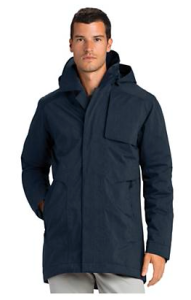
Luckily for you, this is a fairly easy problem to solve. All you need is an umbrella or a rain jacket, and you’ll be fine. You might be doing this anyway, but it’s especially important if you’re somewhere cold, and goose down is your body-heating weapon of choice.
It’s possible to find waterproof down jackets, and chemically treated goose down that’ll perform significantly better in the rain, but these can be fairly expensive, whereas you might have a rain jacket already anyway, so you might as well use it. They’re not a bad idea, though.
Keep in mind that if it’s below freezing the whole time, you don’t need to worry too much about rain.
On the other hand, you can go synthetic:
What about a synthetic packable jacket?
Though nothing on the planet seems to be as good as goose down for insulation and compressibility, synthetic insulation has one major advantage: It’ll work in the rain. While down wilts when it’s damp, synthetic insulation will retain some insulation value, and it’ll dry quickly. This can be incredibly helpful if you find yourself caught in a rainstorm without real rain protection.
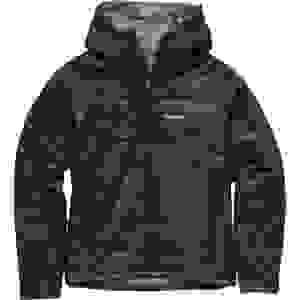
So although a synthetic packable jacket won’t offer the weight or compressibility advantages of goose down, it’ll get fairly close (still better than fleece), and that might be all you need. And as an added bonus, it’s almost always cheaper than down. Plus it’s vegan!
I wouldn’t say there’s a “correct” answer between down and synthetic, as it just depends on how you plan to use it, and how much you can spend.
Personally, I’ve used a synthetic, hooded, insulated jacket for years, and if it rains a little, I’ll probably be fine. For city travel, where you can duck under cover occasionally, it works.
But if you’re planning on walking around for hours at a time and you don’t want rain holding you back, you’ll definitely need a real rain jacket or an umbrella, regardless of whether you’re using down or synthetic. But you’ll definitely want real rain protection if all you’ve got is goose down.
Do I need a hood?
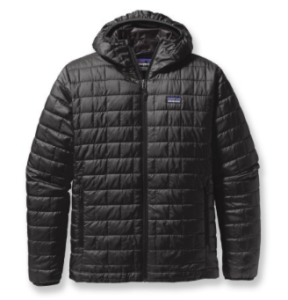
This is a bit of a tangent from the previous segment, and, again, just depends on how you want to handle things. If you’ve got a synthetic jacket and don’t mind walking around in the rain for a few minutes at a time, hoods are great. If you’re using goose down, you’ll probably want an umbrella or a rain jacket, in which case the hood might be kinda useless.
It’ll come down to personal preference, but hoods make a lot more sense for synthetic jackets, since they’ll be able to handle a little rain without much trouble. If you’re using down, you’ll probably want to rely on a real rain jacket, which will have its own hood anyway, unless you’re using a waterproof down jacket.
How about a vest?
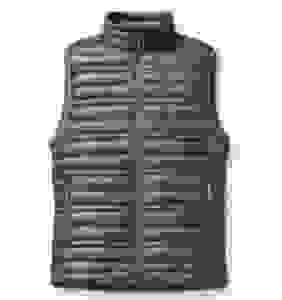
Vests are a good alternative to a big puffy jacket, since they’ll keep your torso nice and warm, without getting too bulky in the sleeves. This is especially helpful if you’re combining several layers together, which eventually makes it impossible to bend your elbows.
I would say that if you’re getting a vest, it makes more sense to use goose down, rather than synthetic. Since it’s only a partial layer, you’ll probably have something like a rain jacket as well, in which case you won’t need to worry about the down getting wet. The only advantage to a synthetic vest in this case would be that it’s usually cheaper.
Is there a best packable down jacket?
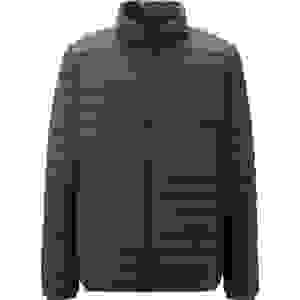
Nah, there’s no such thing as the best down jacket, as it often comes down to personal preference regarding fit, features, fabric, and so on. They’re all using the same raw material anyway. Remember that it’ll probably have to fit together with other pieces, so it’ll have to be looser than a fleece jacket or sweater, but slimmer than a rain jacket, and suitable for your body type.
That said, all the jackets and vests featured on this page are highly regarded items from reputable brands, many of which back their products with thoroughly impressive warranties. I also tried to pick the ones that have been around for years, rather than this-year-only models that’ll disappear sooner or later. There are certainly plenty of other great items out there, but the items listed above will be rock solid, and follow you on plenty of adorable adventures all over the world.
I am, however, happy to point people to Patagonia and North Face, who are working to eliminate problems with animal abuse in the supply chain. If you’re at all worried about the treatment of the animals involved, those are great places to look.
A little note on repairs: It’s easy to patch torn fabric with super-strong tape, and there’s a really neat set of repair tape from McNett, known as Tenacious Tape Tattoos. Not only do they create a permanent repair job, but they’re also cut into fun shapes, like dinosaurs, stars, moons, and other neat doodads. Instead of your jacket looking like it’s torn apart and taped over, it just looks like you’ve added some flair. McNett sent me a couple free sets, and I’m no longer dreading the moment my down jackets get torn apart, but looking forward to adding some fun nature scenes to them.
Have fun!

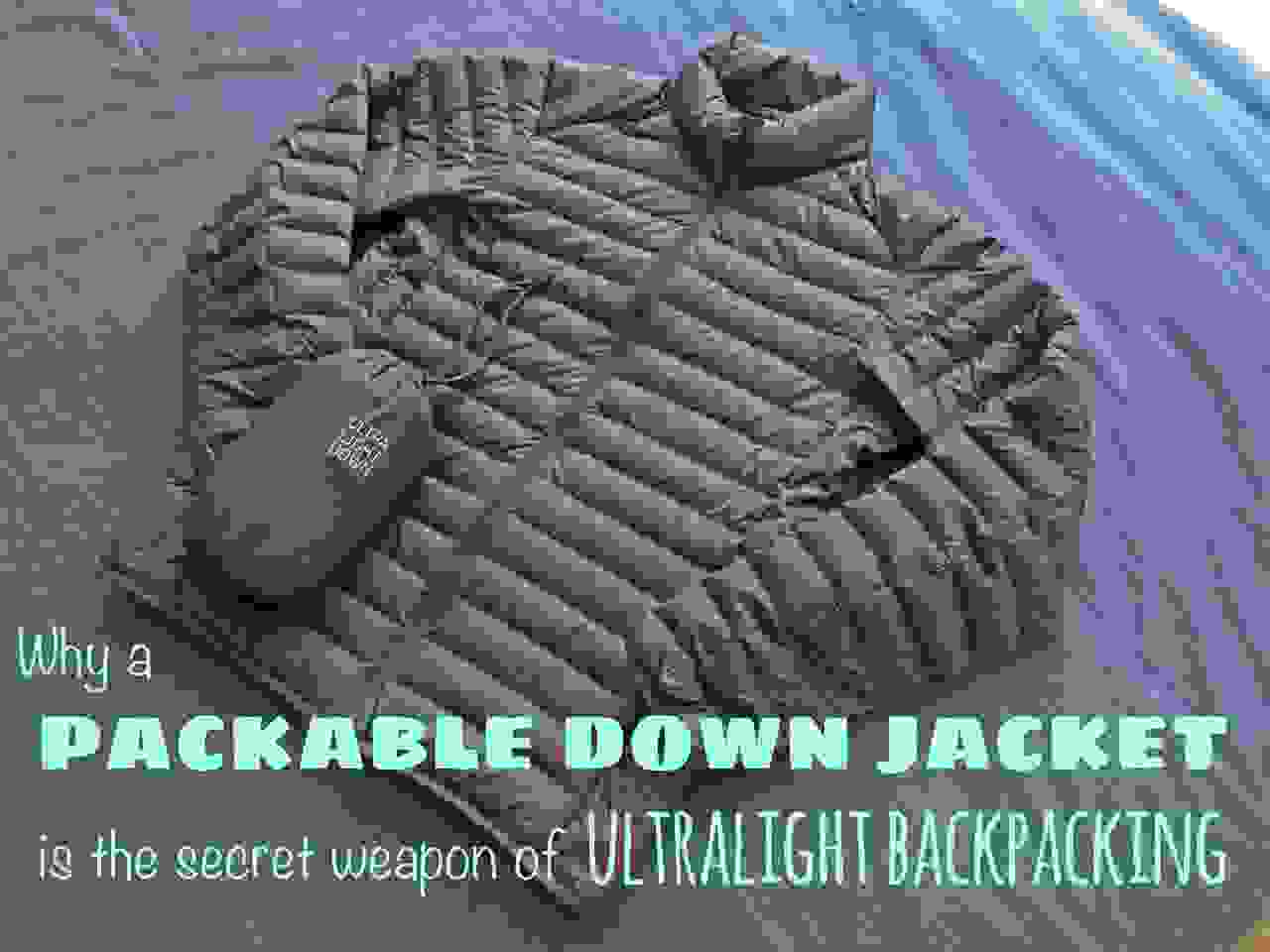



I’m in the market for a new down jacket. I’ve worn the same Sierra Designs down jacket I bought in 1975—nylon taffeta (no ripstop) with reversible colors, orange interior and tan exterior. It has been an awesome lightweight down jacket, even with its ‘antiquated’ technology. I was never sure if it really was designed to be a packable jacket, with the taffeta, however, during the past 40 years, it has been stuffed into a backpack, day pack and portage bag in between stoves and tents, with no ill effects.
My question is, why would the Patagonia 800-fill sweater be more packable than the Marmot Jena, which is not rated as packable? Also, would you happen to know what the minimum temp rating is for the Patagonia sweater?
Thanks for the article.
I expect both of them would be packable, and there’s no official rating for what counts as packable and what doesn’t, so it’s probably just that Patagonia is saying its jacket is packable just to remind people about it, and Marmot just isn’t mentioning it. However, the Patagonia is using 800 fill power down, instead of the Marmot’s 700, which means its down is warmer for its weight, and more compressible (though that doesn’t necessarily mean the entire jacket will be warmer or more compressible overall, since a 700 fill power jacket can just use more material, and it’ll be warmer, but heavier), but I expect the difference between 700 and 800 will be practically unnoticeable.
Also, the Marmot Jena is using water-resistant down, which is a lot better if you get caught in the rain and your jacket gets saturated. I think that’s the more important distinction between the two. Obviously no rain is good, but the Marmot will help you out if you forget the rain jacket at home, whereas with the Patagonia it’s more important to bring a raincoat or an umbrella if you live or travel somewhere rainy. You can achieve this water resistance by using synthetic insulation, which will be cheaper, though it won’t be quite as warm or packable compared to a down jacket of the same weight. There’s no correct answer here, but I think the water resistance is the thing to think about, more so than the fill power. Fit and overall comfort, too. Though Patagonia is using traceable down, which means no abused animals, so that’s important to take into consideration as well.
Your website is extremely wonderfully written and helpful! Thank you!
We are planning a trip to Patagonia Chile with our 4 sons in the spring, and are currently researching which layers would be best for them. Just wondered if you would have any ideas about whether to go for the Nano Puff or the Down Sweater. Ideally we would check them out in person, but they are not available anywhere near us, and we would have to order online. Thanks for any thoughts you could share.
Both of them will work well, so the only real difference is that you can get the Nano Puff wet without running into much trouble. If down gets wet, it stays wet, and doesn’t insulate, whereas synthetic insulation still keeps you warm (somewhat), and can dry quickly. I would venture a guess and say that kids might jump in puddles and things like that, so I might go for the synthetic of the Nano Puff.
Hi there,
How can I tell what fill power these jackets are if it’s not indicated?
http://www.uniqlo.com/us/women/outerwear-and-blazers/down.html
Thank you kindly!
Eunice
I’ve read that Uniqlo’s is somewhere around 700. I’ve read that their numbers are a little lower, but they use a European scale or something like that, so in the American scale, 700 is about right. But that might be different for different jackets, and most of them use a bit of duck down, instead of just goose down, to lower the price. Definitely not bad, and a good budget option for those who don’t need the absolute best.
My backpack’s waist belt buckle sometimes damages my jackets – I have an ultralight jacket, but really think it will rip it after 20 miles of hiking. Any experience with this? I might need to tighten my wast belt so it doesn’t move as much.
Thanks,
Jason
Yeah, it sounds like it’s too loose, and it’s moving around. One thing you can try is just tying a soft strip of fabric around your waist. I’ve done this for packs that didn’t fit right, when I was younger, and the belt dug into my hips and hurt quite a bit. A scarf is probably the best way to do it.
I’m going backpacking in a few months around Europe, Asia, and Australia and
recently purchased a North Face Nuptse 2.
http://www.millets.co.uk/mens/105660-the-north-face-mens-nuptse-2-jacket.html
and was just wondering whether or not you think it is a good choice or if I should exchange for a jacket with a hood?
Hoods are definitely a matter of personal preference. If you plan on carrying an additional rain jacket anyway, then it’s fine. You can also just use an umbrella, which is really cheap, and also protects your backpack, as well as maps when you pull them out to look at them, and your camera while you’re taking pictures, and so on. Hooded jackets don’t have that kind of versatility…although they do allow you to use both your hands instead of just one, and they don’t turn inside out when it gets really windy.
That jacket is going to be reeeeeaaaallly warm, though. Even in deep winter, you could probably wear just a t-shirt underneath and feel just fine. That’ll work if you plan on wearing just shirts underneath (including collared shirts), and maybe a really, really light sweater, but it’ll probably be way too much if you wear a fleece jacket underneath, for example. Not that there’s anything wrong with doing things that way, but just a heads up. It’s about double the weight of the Patagonia Down Sweater, for example, which is a fall jacket on its own, and a winter jacket if you wear something like a light wool or fleece layer underneath. I tend to get overheated pretty quickly, especially when I’m walking up and down hills all day, which is why I pack multiple lightweight layers instead of one big one.
This is one of the best recommendations I’ve gotten from your site.
Happy to hear that. It’s so satisfying to see a warm jacket pack down to nothing…
I just recently got the Alchemy Equipment Wool Down “Shacket” http://www.alchemy-equipment.com/catalog/product/view/id/4376/s/wool-performance-down-shacket/category/37/
It has a Teflon coating and uses a 750 fill Primaloft/goose hybrid. Very light. They are too hot above the low 60s. I’m guessing it will go to the 40s without layering. The design is a perfect balance of utility and fashion IMHO. You can get them at a steep discount at Backcountry. Anticipate using it this fall on trips to the Netherlands, England, and Colorado.
I need to add a rainjacket.
Yeah, I like that company. They seem to have a good sense of how not to look silly.
Companies like AE are not only preventing the traveler from looking silly, but are actually making them look quite stylish–as good as you’d want when travel is not a factor at all. It’s going to be an exciting time over the next 5 years as I expect technical or performance menswear will begin to really take off….
Hello! I was wondering if you’d recommend the Patagonia nano puff down jacket for a December trip to Montreal, Quebec? I’m trying to figure out what coats we all need. I would pair it with the torrentshell jacket as an outer layer when needed! Thank you!
I know that one, although I haven’t used it, but synthetic materials work nicely in wet weather, and Patagonia is a great company. It’ll definitely work.
My husband, two teenage boys, and I are traveling to Iceland in December. We are likely to encounter wet weather and temperatures ranging from below freezing to about 40F. If we are out on a hike/walk that gets rainy, would you suggest we have rain jackets big enough to put OVER the down jackets, or would we take off the down jackets and put the rain jackets on instead? And, if so, would we then be cold and need to put on fleece pullovers?
This is why I like the layering approach; I like to have a light layer underneath the down, like a wool sweater or a fleece jacket, that isn’t particularly heavy. When you’re on a hike, you’ll be working up a sweat, and probably won’t want to wear the down. You’ll either be wearing the fleece on its own, or maybe the rain jacket too. But I still think it’s probably a good idea to get a rain jacket that can go over the down jacket, with the exception of super puffy ones, intended to be worn only in really far below freezing temperatures, in which case it’s never going to be raining while you’re wearing it. This way if you’re walking around in a campground or a site or whatever, you can still get rain protection, as well as warmth. It’s helpful when you’re just kind of standing around, not building up any body heat, to have that down warmth.
Hi, I just moved from asia to Canada. It’s my first time living in a cold climate, and I know the winters here can sometimes be brutal & I plan on using it for many years. I just bought http://www.sears.ca/product/alpinetek-womens-packable-down-jacket/1712763160?gclid=CJ2ltNXH0M8CFYOFaQodsQIHJw&extid=ca_1search_2en_3gogl_4productfeeds&s_kwcid=AL!4202!3!{creative}!{matchtype}!{placement}!{network}!{adwords_producttargetid}!{keyword}&ef_id=Vs-oQAAABVqYRa8W:20161010153318:s but am having second thoughts. I’ve never had a down or packable jacket. I just jumped on it because it was half price. If I’m planning to use it for daily 20mins walks to school, should i go for a parka-like jacket? something like this instead? http://www.sears.ca/product/alpinetek-down-bomber/617-000013144-X31278
Or should I look for something else that offers waterproofing, insulation and durability. Living in winter and vacationing in winter seems to be something of a trial & error/live & learn. But any advice would be greatly appreciated!
The second one looks far more water resistant and heavy-duty than the first. The first one looks more like a very lightweight piece, which is nice, but it won’t stand up to scratches or rain as easily. Generally I like using lightweight/ultralight down so that it can go underneath a rain jacket if necessary, whereas the second one looks much tougher. Not waterproof, but significantly more water resistant. But that’s just my guess from the photos. The first one would be good if you can combine it with an umbrella or another trench-like coat, but the second one will be heavier, but more capable.